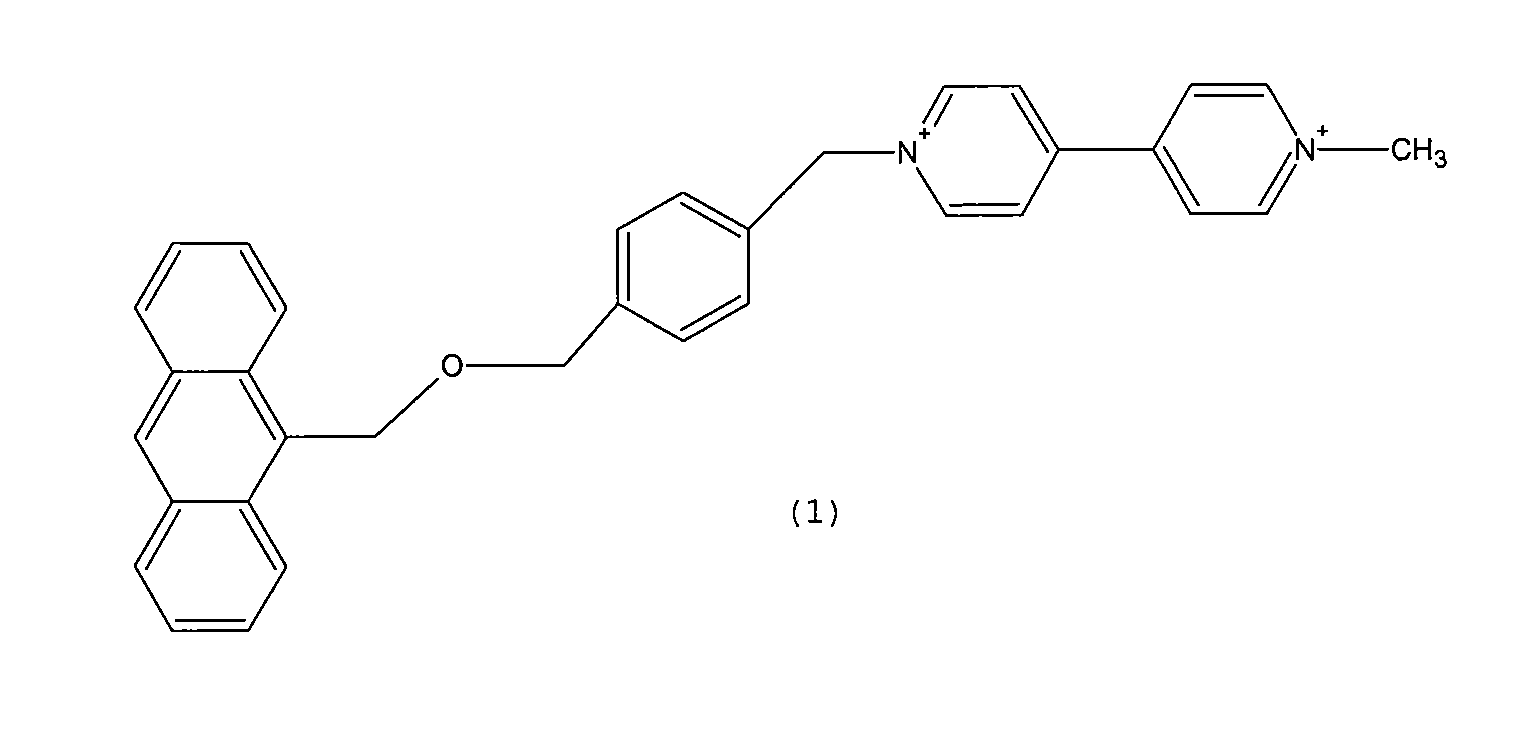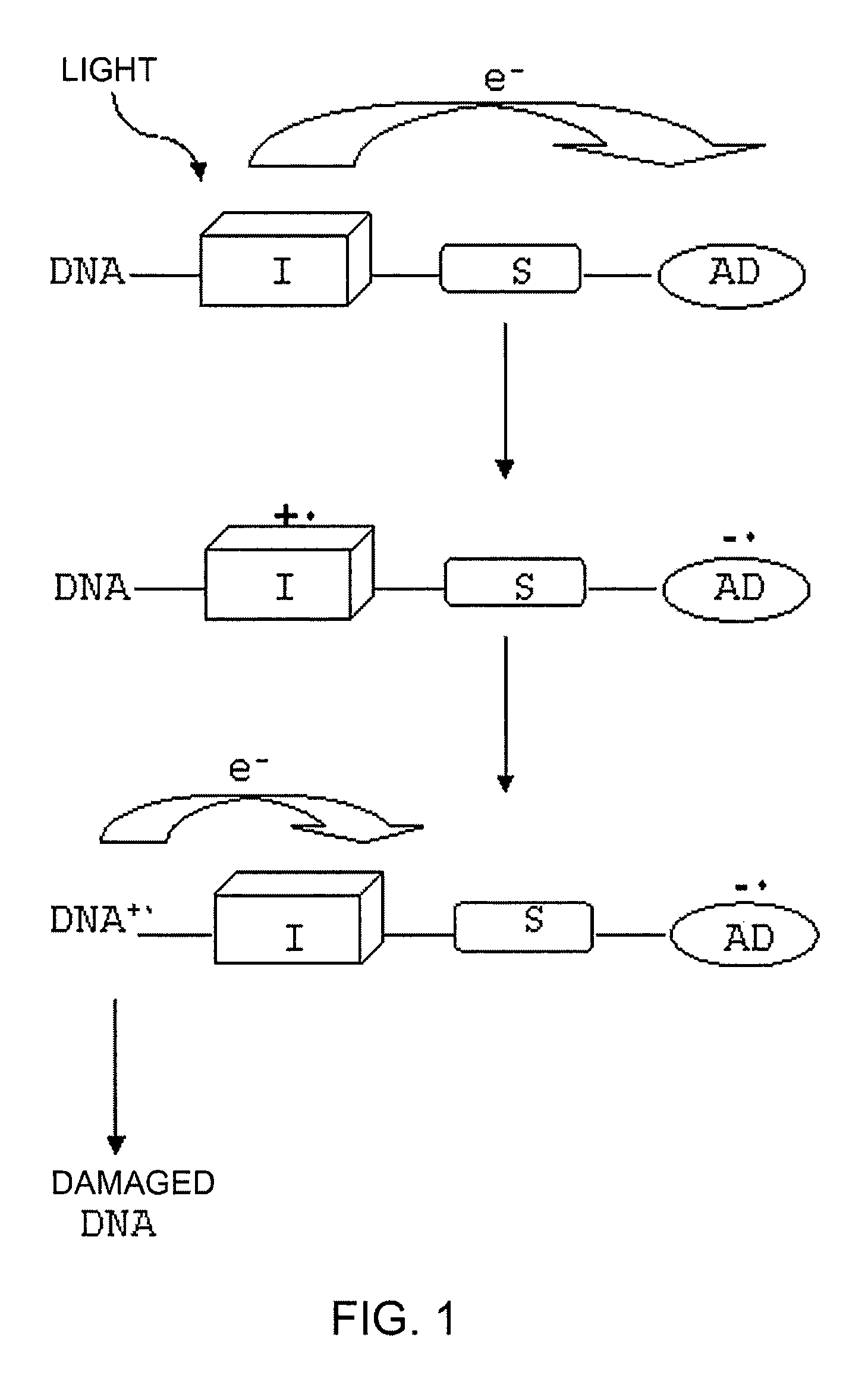Bifunctional chemical, preparation and use for detecting nucleic acid
a chemical compound and bifunctional technology, applied in the field of bifunctional chemical compounds, can solve the problems of reducing reducing the accuracy of detection, and requiring the use of optical devices and/or fluorescent markers, etc., so as to improve prevent cleavage of nucleic acids, and optimize the sensitivity and specificity of detection
- Summary
- Abstract
- Description
- Claims
- Application Information
AI Technical Summary
Benefits of technology
Problems solved by technology
Method used
Image
Examples
example 1
Synthesis of Compound 1
[0054]The reaction of synthesis of the compound of Formula 1 is summarized in scheme 2.
[0055]
[0056]500 mg of (anthracene-9-yl)methanol (M.W. 208.26 g / mol, 2.4 mmol) was solubilized in acetonitrile to obtain a yellow solution. The latter was heated under reflux (82° C.), and nitrogen was bubbled therein.
[0057]70 mg of sodium hydride (M.W. 24 g / mol, 2.9 mmol), previously washed with hexane and then suspended in acetonitrile, was added. After approximately 30 minutes, the mixture assumed a red coloring.
[0058]At this point, a solution prepared by solubilizing 1.3 g of α,α′-dibromium para-xylene (M.W. 263.97, 5 mmol) in acetonitrile was added. Reflux was maintained for 16 hours.
[0059]The reaction was followed via TLC (thin-layer chromatography) on silica using as eluent mixture cyclohexane / dichloromethane (1:2). Formation was thus noted of some by-products and of a very intense spot at Rf 0.77, as well as spots corresponding to the unreacted ingredients.
[0060]The s...
example 2
Characterization of the Compound 1
[0066]The compound of Formula 1 was designed in such a way that the intercalating unit is photochemically inactive with regard to DNA, in order to prevent any damage thereto under conditions of ambient light.
[0067]FIG. 2 shows the absorption spectra of anthracene methanol, chosen as model reference compound, and of the bifunctional compound of Formula 1. The spectral similarity of the two traces clearly suggests the absence of interactions between the anthracene unit and viologen in the ground state.
[0068]Differences were instead encountered at the level of the excited states. FIG. 3 shows the fluorescence spectra of anthracene methanol and of the compound of Formula 1. As may be noted, the typical emission of the anthracene chromophore is totally deactivated in the compound of Formula 1 by the presence of the viologen group.
[0069]Deactivation of the triplet state of the anthracene ring in the compound of Formula 1 was confirmed through flash laser ...
example 3
Interaction Between Compound 1 and DSDNA
[0070]The high photostability of the compound of Formula 1 in the presence of DNA was demonstrated through flash laser photolysis experiments carried out at DNA concentrations that ensure 100% of binding of Formula 1 to DNA. The absence of a signal at 600 nm due to the reduced form of the viologen suggests that the return of the electrons from the viologen to the anthracene ring is the dominant process that regulates oxidation of the nucleobases from the oxidized form of anthracene.
[0071]The study of the interaction of the compound of Formula 1 with DNA is conducted by analysis of its absorption properties. In particular, the absorptions at the higher wavelengths enable observation of possible modifications following the addition of DNA without being affected by the absorption thereof, which terminates at approximately 300 nm.
[0072]FIG. 5 shows the spectral variation observed in the absorption spectrum of the compound of Formula 1 following su...
PUM
| Property | Measurement | Unit |
|---|---|---|
| temperature | aaaaa | aaaaa |
| wavelengths | aaaaa | aaaaa |
| reduction-oxidation potential | aaaaa | aaaaa |
Abstract
Description
Claims
Application Information
 Login to View More
Login to View More - R&D
- Intellectual Property
- Life Sciences
- Materials
- Tech Scout
- Unparalleled Data Quality
- Higher Quality Content
- 60% Fewer Hallucinations
Browse by: Latest US Patents, China's latest patents, Technical Efficacy Thesaurus, Application Domain, Technology Topic, Popular Technical Reports.
© 2025 PatSnap. All rights reserved.Legal|Privacy policy|Modern Slavery Act Transparency Statement|Sitemap|About US| Contact US: help@patsnap.com



